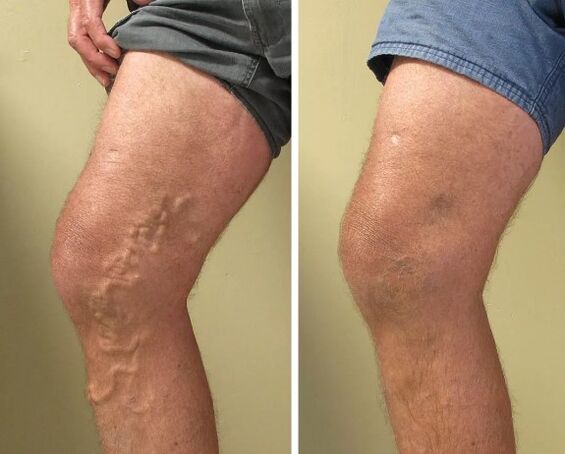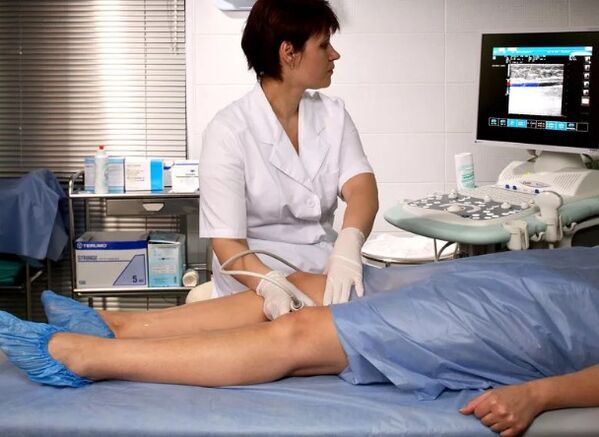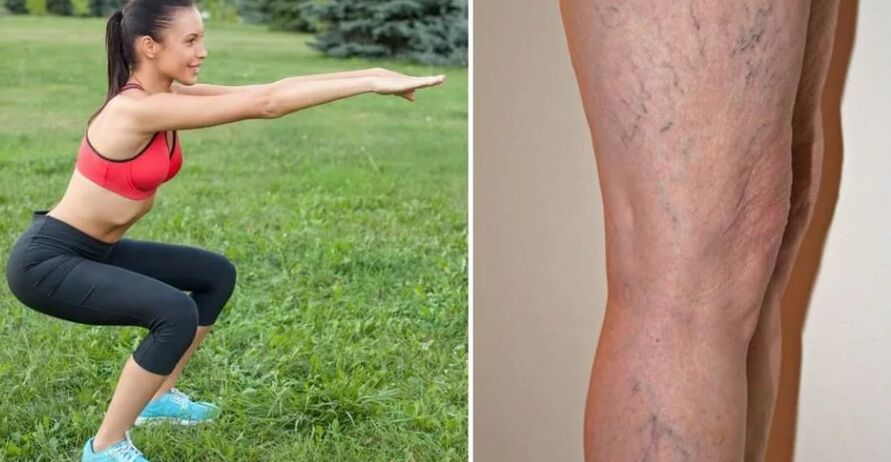Varicocele on the legs is a specific expansion of the lower limb veins, accompanied by general invasion of blood flow and valve failure. Dilation of veins is a characteristic of men and women aged 40 to 60.

Development mechanism
The trigger of varicose veins is considered to be the trigger of normal surgery on the venous valve (reflux - reverse current). At the cellular level, this is associated with violating the balance between certain components of the venous wall.
The initial stage is characterized by the presence of genetic factors and factors (staying in the sitting position for a long time, excessive weight, injury, etc. ). Meanwhile, the so-called shear stress parameter changes, which is a set of blood movement indicators through blood vessels, to which the endothelium is very sensitive.
If the stimulator acts on the wall of the blood vessel for a long time, the white blood cells are firmly fixed to the endothelial cells, which leads to the initial stage of inflammation. The inflammation process spreads through the venous channels of the lower limbs.
Especially soon, this process occurs in the valve, which conforms to constant, constant mechanical stress. However, inflammation in one leg is more obvious than inflammation in the other leg. First, it depends on the initial cause of organ damage, for example, on the right leg, varicose veins can be more pronounced in athletes who emphasize it.
Due to damage to the valve, the pathological excretion of blood occurs through the oral cavity of the subcutaneous veins of a large size. Due to rebooting, excessive blood flow occurs and the walls of the venous blood vessels occur.
Over time, dynamic venous hypertension develops, characterized by a decrease in pressure in the blood vessels, usually occurring during walking, to levels that cannot ensure normal blood perfusion through the tissue.
This process is accompanied by edema, and subcutaneous tissue is impregnated with blood cells (red and white blood cells). Over time, the skin changes its color and expands, and skin pigmentation increases. With the death of cells, this is not indecent in the healthcare process, which further leads to the development of nutritional ulcers.

Classification of varicose veins
Since 2000, a new classification of varicose veins in the lower limbs has been developed.
Varicocele Form:
- intradermal or segmental varicose veins without pathological changes;
- venous return of segmented varicose veins;
- Common varicose veins in surface veins;
- In the presence of deep vein reflux, varicose veins swell.
The degree of chronic venous insufficiency:
- 0-Not developing;
- i-"heavy legs" syndrome, edema appearance;
- II-Sustained edema, eczema, fat membrane sclerosis;
- III-Nutritional ulcer.
Complications of venous swelling of lower limbs are one of the serious diseases that affect the body: thrombophlebitis, nutritional ulcers, erysipelas, erysipelas, erysipelas, erysipelas, or bleeding.
Disease work classification
By form:
- Varicocele in the subcutaneous vein of the thigh (starting from the mouth) - descending vein vein;
- ascending varicose veins (starting from the bottom, failure of lower legs and feet, calf and feet);
By the clinical group:
- The first group is the internal expansion of the vein without a perforator.
- The second group is the expansion of venous trunk fragments.
- The third group is the expansion of the subcutaneous veins of the thigh;
- The fourth group is the varicose veins of the subcutaneous veins of the size and size, with the presence of a perforator that is unable to dissolve.
- The fifth group is the expansion of the surface veins, a subcutaneous vein with a tissue-induced size.
There was no difference between the classification of work and the degree of chronic failure of complications and the criteria.
Causes of varicose veins development
The exact cause of this pathological development has not been fully clarified, but there are many factors that lead to the occurrence of varicose veins:
- genetic predisposition (mutant genes responsible for the structure of the blood vessel wall have been spread);
- Changes in hormone background (pregnancy - changes in the composition of hormones in the body during pregnancy (increasing the amount of progesterone, decreasing the amount of estrogen), which directly affects the formation of blood clotting factors);
- Obesity (overweight can lead to a sedentary lifestyle that leads to rupture);
- Diabetes (the blood sugar that increases in blood sugar can damage the blood vessel walls over time);
- Alcohol abuse (a large amount of alcohol in the blood is the cause of blood dehydration and condensation);
- Focus on physical exercise;
- Congenital blood clotting disease;
- Irrational nutrition, dietary errors;
- Inconvenient and close-range underwear (continuous wear can lead to vascular compression);
- Frequent constipation (increased pressure in the abdomen can cause difficulty in blood flowing out of the lower limbs);
- Continuous walking (stagnation and development of insufficient muscle movement);
- The temperature of the air increases (causing dehydration, condensing the blood, which leads to the formation of blood clots);
- cardiovascular system and kidney disease;
- Drugs that increase blood clotting with drugs overdose;
- Surgical interventions (hemorrhage, vascular compression).

The stage of varicose veins
During this period of medical development, when the disease is difficult to notice, the three main stages of varicose vein development and early stages will be distinguished.
The early stages of the disease are accompanied by swelling, weight, and often sick leave complains about the injury to the legs during long journeys. These are signs of pathology starting, and it's time to start preventing - massage, leg cream, physical exercise.
Expansion of primary veins.This stage is characterized by all the symptoms listed above, even vascular stars, bruises on the legs, knotted veins, visible on the skin. In addition, nighttime twitching and the occurrence of combustion in the stop area were noted.
Swelling of secondary veins.At this stage, the total number of stars and nodes increases, and they become more obvious. Swelling occurs, increased leg pain and enduring it becomes unbearable.
The third degree of venous swelling.This is the most difficult on the stage, accompanied by severe lesions in the leg skin, which becomes dry, inanimate and ruptured. The skin on the lower leg turns dark blue, and its structure and pigmentation are changing.
The third stage is the last one when the last pathological process is called varicose veins. The subsequent process stops to more severe disease.
It is recommended to consult a doctor during the second stage of disease development, as health care will not have serious consequences over time.
The question immediately emerged: "Which doctor will he go to? " The answer is simply - a doctor who specializes in the pathology of lower limb veins is called a wanderer.

Symptoms and varicose veins in the clinic
The main sign of this disease is the massive extension of the subcutaneous vein, which is why the disease is. The onset of the disease is usually accompanied by some and nonspecific characteristics.
In this state, the patient will feel the severity of the legs, quickly fatigue during exercise, and sometimes burn and cramp. In addition to pain, the disease also manifests itself as hard-working afternoon edema.
For a long period of time, symptoms such as eczema and itching appear. The patient scratched his legs and felt uncomfortable. As the disease progresses, the skin above the veins becomes thinner and the itchy areas are combed, causing the wound to appear.
As time goes by, the skin tone of the lower leg becomes blue. If medical care is not provided in this case, skin pigmentation and fat embolism can be developed. At a higher level, nutritional ulcers develop.
diagnosis
The diverse veins are visible and not armed, however, instrumental diagnostics must be used to find out how dangerous this condition is.
Currently, the most useful method is the ultrasound method of intravenous duplex scanning. With its help, it can be evaluated by the operation of the valve, the ability to transnationally and the presence of blood clots. Timely study of the vein will avoid serious and irreversible consequences.
Treatment method
How to treat varicose veins? Only with the help of surgical intervention can varicose veins be completely cured. People with hereditary tendencies or risk factors recommend going to a professional doctor 2-3 times a year to perform ultrasound to perform ultrasound on the veins, and surgery for varicose veins is performed in the second stage of the disease development.
How much does it cost to operate? Prices can vary, depending entirely on the severity of the disease development.

Surgical treatment
Ovalectomy
Indications for clearing veins: extensive varicose veins, pathological dilation of subcutaneous veins, nutritional ulcers, acute thrombotic varicose veins, dilation of deep veins is accompanied by general discomfort (fatigue, dizziness).
Contraindications to the disease: coronary heart disease, pregnancy, age of the elderly, severe infectious diseases, inflammatory processes.
The advantage of surgical treatment is that it is the only effective treatment in the advanced form of the disease.
Disadvantages of this treatment: trauma, anesthesia, and long-term postoperatively.
Laser Therapy (EVVK)
Indications: Varicocele on the legs is used in combination with various serious diseases (ischemia, platelets, asthma, bronchitis, pleuritis, ulcers, cholecystitis, cholecystitis, pyelonephritis, peritonitis, peritonitis, dermatitis and boiling).
Laser treatment is contraindicated when noted: oncology, liver disease, kidney, heart (compensational stage), pregnancy and brain sclerosis.
The advantage of this treatment is to eliminate vascular patterns, maximum rapid procedure, painless and safe, without the need for fixed observation and fanaticism.
Cons: Not available at all, expensive, with scars or clarification of surrounding fabrics.
Radiofrequency coagulation in venous veins
Indications: Varicocele, damage to the trunk of the size of subcutaneous veins, nutritional ulcers.
Contraindications: Acute form of thrombotic varicose veins, mental disorders, pregnancy.
Advantages: No pain is required after the operation, no hospitalization is required, and no interference with work.
Disadvantages: Expensive programs.
Sclerotherapy
Indications: Early varicose veins.
Contraindications: pregnancy, breastfeeding, sclerosis to the legs, allergic reactions to suppurative inflammatory processes, thrombosis.
The advantage of this treatment is that this treatment is financially cheaper than surgery, with quick recovery, optimal cosmetic effects.
Disadvantages: Perhaps entering the deep vein of the sclerants is not effective enough for advanced forms of the disease.
Drug treatment
Drug treatment helps improve blood vessels and valve status, enhance blood and lymphatic flow, and eliminate inflammation, but does not cure the patient.
How to treat it?

All necessary products in varicose veins are divided into:
- Bloodletting Museum;
- Non-replacement analgesics;
- Hormonal drugs;
- Resist orcs;
- Aspirin-based medicine.
Family therapy
Traditional medicine provides the use of various ointments, lotions, tin agents, feet or decoctions.
Apple cider vinegar treats varicose veins. However, it is impossible to cure the disease with folk recipes to reduce the authenticity of the symptoms, especially in the initial stages of development. For this purpose, apple apple cider vinegar is used for wrapping, wiping, oral administration or compression.
How to avoid getting sick?
A sedentary lifestyle, routine, pregnancy is a greater burden, so diseases such as varicose veins will develop.
The variables for women are the same as cellulite, so special creams, lotions, compression stockings and lymphatic drainage were developed to combat it.
According to statistics, varicose veins in men are extremely rare, even if they develop more slowly.
Can I participate in sports?
Diversity and running are two factors that always walk around. The most effective prevention of venous swelling at any stage is continuous physical fatigue: running, gymnastics, various strength exercises on the legs, cycling, etc.
There are many simple exercises that can improve blood flow and prevent varicose veins:
- The foot rotates clockwise 20 times in each direction.
- Work with your fingers. Stretch your fingers and plug 20 times.
- Wear socks, then heels, then roll from heels to socks, and then go back 20-30 times.























